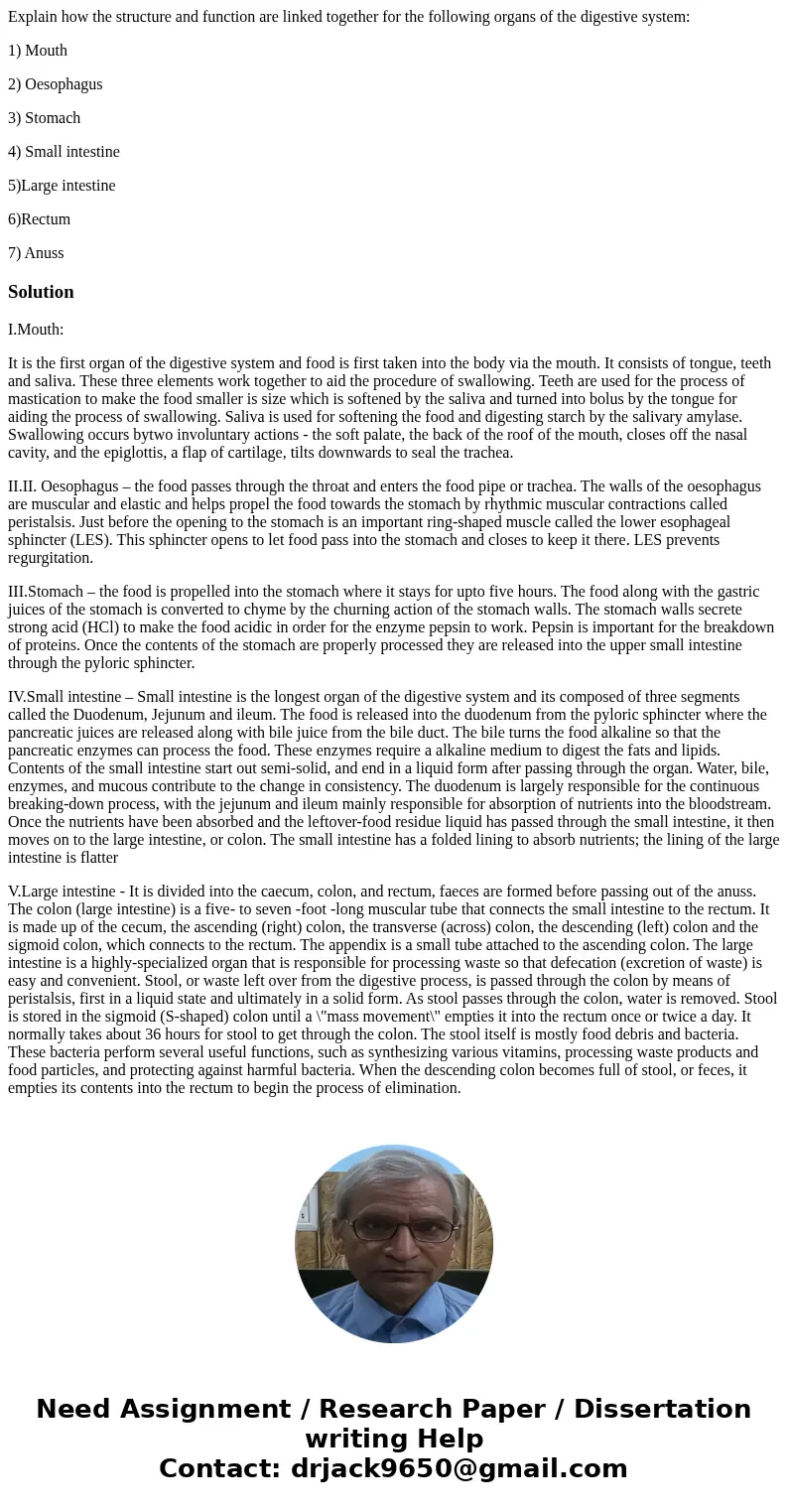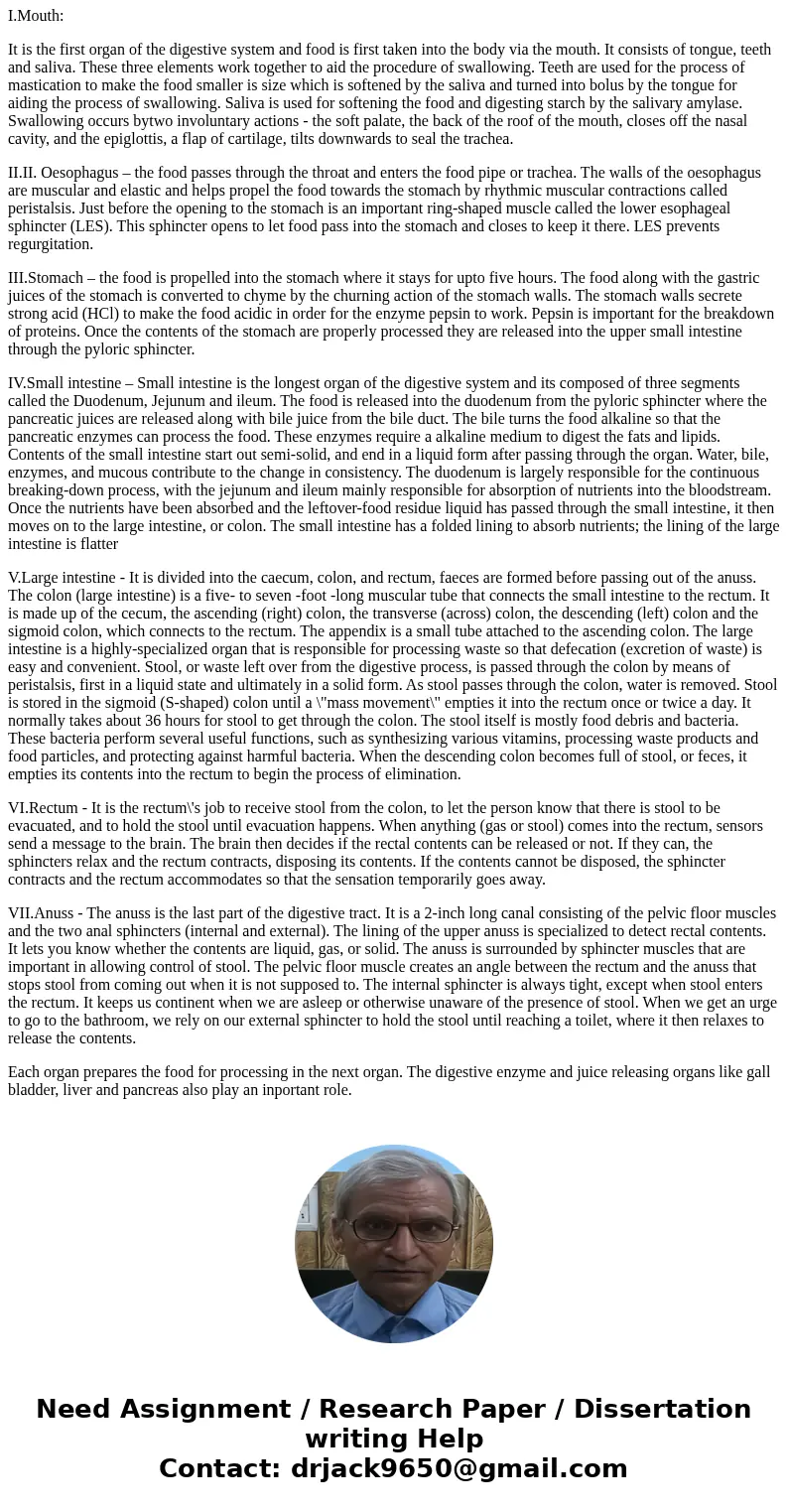Explain how the structure and function are linked together f
Explain how the structure and function are linked together for the following organs of the digestive system:
1) Mouth
2) Oesophagus
3) Stomach
4) Small intestine
5)Large intestine
6)Rectum
7) Anuss
Solution
I.Mouth:
It is the first organ of the digestive system and food is first taken into the body via the mouth. It consists of tongue, teeth and saliva. These three elements work together to aid the procedure of swallowing. Teeth are used for the process of mastication to make the food smaller is size which is softened by the saliva and turned into bolus by the tongue for aiding the process of swallowing. Saliva is used for softening the food and digesting starch by the salivary amylase. Swallowing occurs bytwo involuntary actions - the soft palate, the back of the roof of the mouth, closes off the nasal cavity, and the epiglottis, a flap of cartilage, tilts downwards to seal the trachea.
II.II. Oesophagus – the food passes through the throat and enters the food pipe or trachea. The walls of the oesophagus are muscular and elastic and helps propel the food towards the stomach by rhythmic muscular contractions called peristalsis. Just before the opening to the stomach is an important ring-shaped muscle called the lower esophageal sphincter (LES). This sphincter opens to let food pass into the stomach and closes to keep it there. LES prevents regurgitation.
III.Stomach – the food is propelled into the stomach where it stays for upto five hours. The food along with the gastric juices of the stomach is converted to chyme by the churning action of the stomach walls. The stomach walls secrete strong acid (HCl) to make the food acidic in order for the enzyme pepsin to work. Pepsin is important for the breakdown of proteins. Once the contents of the stomach are properly processed they are released into the upper small intestine through the pyloric sphincter.
IV.Small intestine – Small intestine is the longest organ of the digestive system and its composed of three segments called the Duodenum, Jejunum and ileum. The food is released into the duodenum from the pyloric sphincter where the pancreatic juices are released along with bile juice from the bile duct. The bile turns the food alkaline so that the pancreatic enzymes can process the food. These enzymes require a alkaline medium to digest the fats and lipids. Contents of the small intestine start out semi-solid, and end in a liquid form after passing through the organ. Water, bile, enzymes, and mucous contribute to the change in consistency. The duodenum is largely responsible for the continuous breaking-down process, with the jejunum and ileum mainly responsible for absorption of nutrients into the bloodstream. Once the nutrients have been absorbed and the leftover-food residue liquid has passed through the small intestine, it then moves on to the large intestine, or colon. The small intestine has a folded lining to absorb nutrients; the lining of the large intestine is flatter
V.Large intestine - It is divided into the caecum, colon, and rectum, faeces are formed before passing out of the anuss. The colon (large intestine) is a five- to seven -foot -long muscular tube that connects the small intestine to the rectum. It is made up of the cecum, the ascending (right) colon, the transverse (across) colon, the descending (left) colon and the sigmoid colon, which connects to the rectum. The appendix is a small tube attached to the ascending colon. The large intestine is a highly-specialized organ that is responsible for processing waste so that defecation (excretion of waste) is easy and convenient. Stool, or waste left over from the digestive process, is passed through the colon by means of peristalsis, first in a liquid state and ultimately in a solid form. As stool passes through the colon, water is removed. Stool is stored in the sigmoid (S-shaped) colon until a \"mass movement\" empties it into the rectum once or twice a day. It normally takes about 36 hours for stool to get through the colon. The stool itself is mostly food debris and bacteria. These bacteria perform several useful functions, such as synthesizing various vitamins, processing waste products and food particles, and protecting against harmful bacteria. When the descending colon becomes full of stool, or feces, it empties its contents into the rectum to begin the process of elimination.
VI.Rectum - It is the rectum\'s job to receive stool from the colon, to let the person know that there is stool to be evacuated, and to hold the stool until evacuation happens. When anything (gas or stool) comes into the rectum, sensors send a message to the brain. The brain then decides if the rectal contents can be released or not. If they can, the sphincters relax and the rectum contracts, disposing its contents. If the contents cannot be disposed, the sphincter contracts and the rectum accommodates so that the sensation temporarily goes away.
VII.Anuss - The anuss is the last part of the digestive tract. It is a 2-inch long canal consisting of the pelvic floor muscles and the two anal sphincters (internal and external). The lining of the upper anuss is specialized to detect rectal contents. It lets you know whether the contents are liquid, gas, or solid. The anuss is surrounded by sphincter muscles that are important in allowing control of stool. The pelvic floor muscle creates an angle between the rectum and the anuss that stops stool from coming out when it is not supposed to. The internal sphincter is always tight, except when stool enters the rectum. It keeps us continent when we are asleep or otherwise unaware of the presence of stool. When we get an urge to go to the bathroom, we rely on our external sphincter to hold the stool until reaching a toilet, where it then relaxes to release the contents.
Each organ prepares the food for processing in the next organ. The digestive enzyme and juice releasing organs like gall bladder, liver and pancreas also play an inportant role.


 Homework Sourse
Homework Sourse